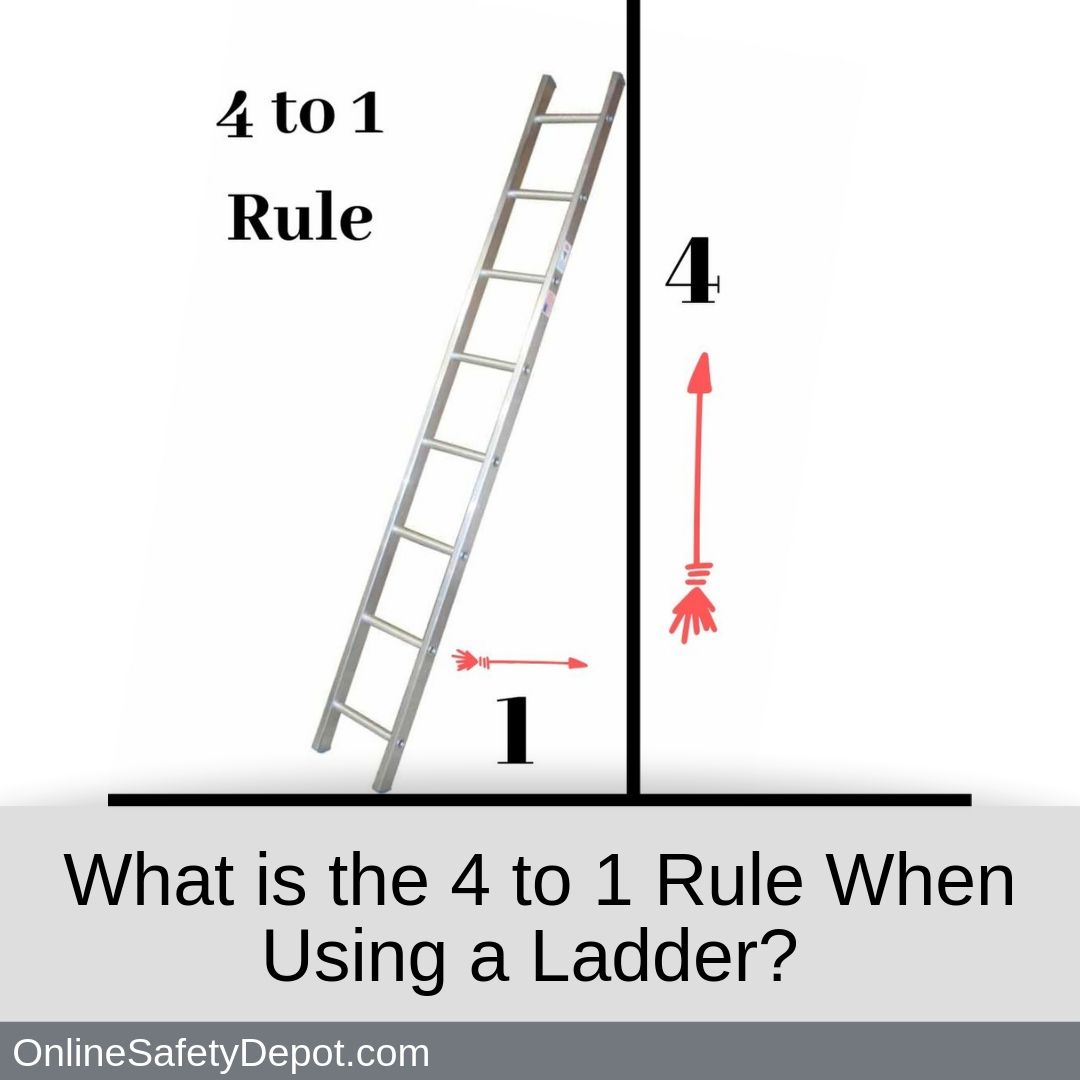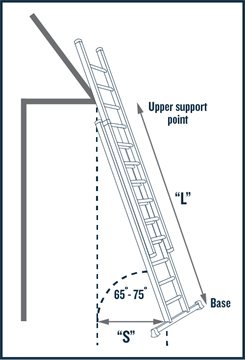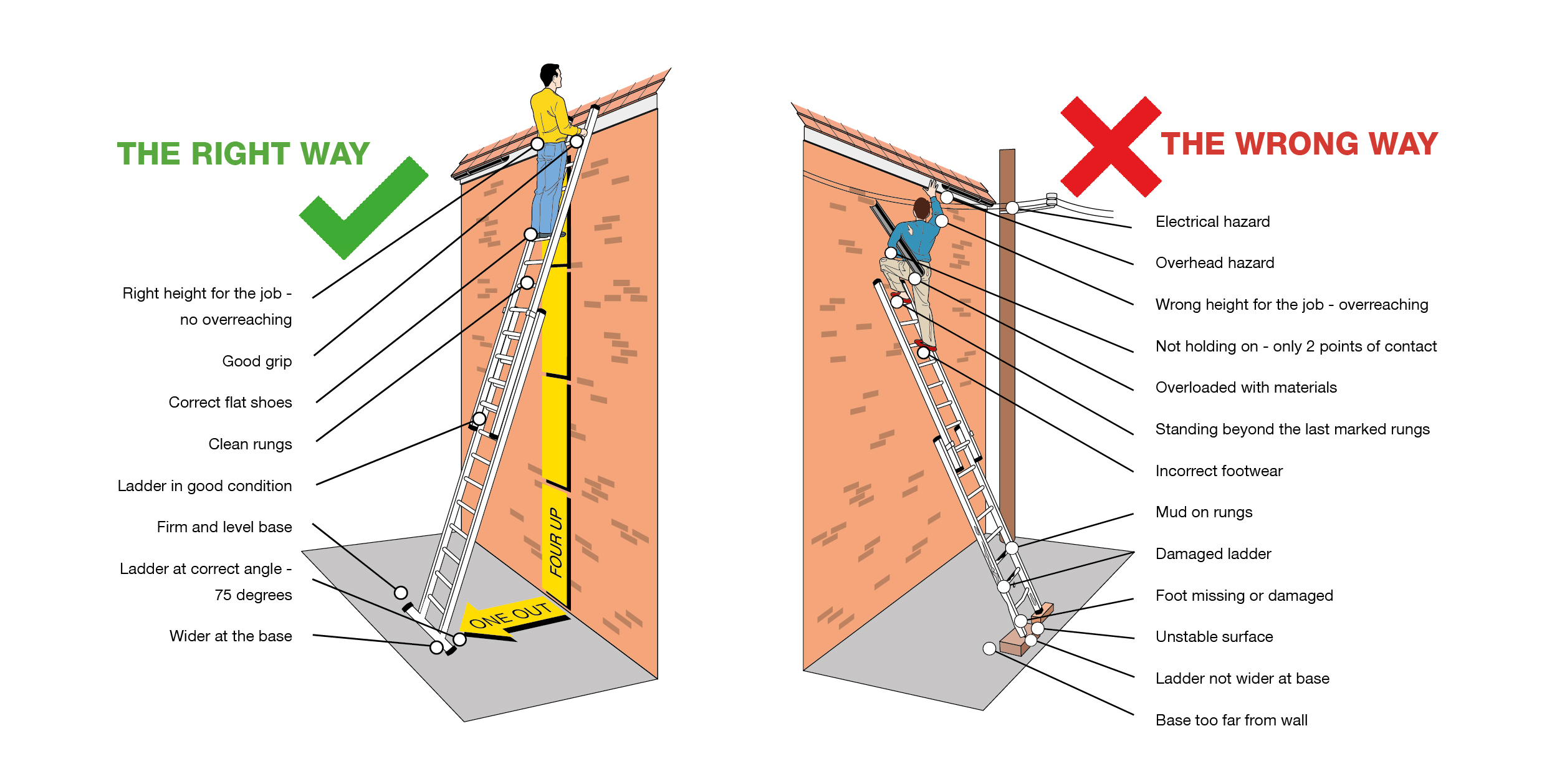The safest angle for an extension ladder is 75.5 degrees. This angle provides optimal stability and prevents the ladder from slipping.
Extension ladders are a common tool for reaching high places, but using them incorrectly can lead to accidents. It is crucial to understand the correct angle for setting up an extension ladder to ensure safety while working at heights. Knowing the safest angle for an extension ladder not only prevents accidents but also increases efficiency and productivity.
By following proper guidelines and safety measures, workers can confidently use extension ladders for various tasks without compromising their well-being. Understanding the importance of the correct ladder angle is essential for anyone using extension ladders in their daily tasks.
Importance Of Ladder Safety
Ladder safety is crucial to prevent accidents and injuries.
Understanding the correct angle at which to position an extension ladder can significantly reduce the risk of falls and ensure a safe working environment.
The Risks Of Ladder Accidents
Improper use of ladders can lead to serious accidents.
Falls from ladders are a common cause of injuries and can result in fractures or even fatalities.
Overreaching on a ladder can cause loss of balance and increase the likelihood of falling.
Significance Of Proper Ladder Angle
The proper angle for an extension ladder is approximately 75.5 degrees.
A correct angle ensures stability and minimizes the risk of the ladder slipping or toppling over.
Maintaining the right angle is essential for safe climbing and working at heights.
Understanding The Extension Ladder
Types Of Ladders
- Extension ladders
- Step ladders
- Platform ladders
Components Of An Extension Ladder
An extension ladder has rungs, rails, and locks. The rungs are the steps you climb on. The rails are the vertical sides of the ladder that provide support. The locks secure the ladder in place when extended.
Finding The Optimal Ladder Angle
Discovering the optimal angle for an extension ladder is crucial for ensuring safety during use. By setting the ladder at the correct angle, you can reduce the risk of accidents and create a stable climbing platform for your tasks. Proper research and adjustment of the ladder angle are key to working safely at height.
Finding the optimal ladder angle is crucial for ensuring safety when working with an extension ladder. Setting the ladder at the correct angle helps maintain stability and prevents accidents. In this section, we will explore how to determine the ideal ladder angle and the factors to consider when setting it.Determining The Ideal Ladder Angle
To determine the ideal ladder angle, you need to follow a simple rule of thumb. The base of the ladder should be positioned one foot away from the wall for every four feet of ladder height. This means that for a 12-foot ladder, the base should be placed three feet away from the wall. This rule ensures that the ladder is stable and won’t tip over.Factors To Consider When Setting The Angle
Several factors come into play when setting the angle of an extension ladder. These factors influence how secure the ladder will be and how comfortable you will feel working on it. Here are some important considerations: 1. Surface conditions: Always place your ladder on a firm and level surface. Avoid setting up the ladder on uneven or slippery ground as it can affect stability. 2. Total ladder height: The height of the ladder is a key factor in determining the angle. The higher the ladder, the greater the angle required to maintain stability. 3. Weight and load: Consider the weight of yourself and any tools or equipment you will be carrying up the ladder. This will impact the ladder’s stability and the angle you should set. 4. Lean angle: The ladder should be leaned at an angle where you can climb it without overreaching. Overreaching can cause loss of balance and falls. 5. Manufacturer’s guidelines: Consult the manufacturer’s instructions for the specific ladder you are using. They may provide specific guidance on the recommended angle for the ladder. Maintaining the proper ladder angle is crucial for safety. By considering these factors and adhering to the one-foot-for-four-feet rule, you can ensure that your ladder is properly positioned and provides a stable platform for your work.Effects Of Incorrect Ladder Angle
When it comes to using an extension ladder, ensuring the correct angle is crucial for safety. Incorrect ladder angle can have various adverse effects, increasing the risk of instability, falls, and accidents.
Increased Risk Of Ladder Instability
Placing an extension ladder at an inappropriate angle can lead to increased ladder instability. This instability results in a higher probability of the ladder tipping over, particularly when bearing weight. Additionally, an unstable ladder increases the risk of wobbling or slipping while climbing or working on it.
Potential For Falls And Accidents
An incorrect ladder angle creates a high potential for falls and accidents. Due to the unstable position, climbing or descending the ladder becomes more hazardous. This increases the likelihood of slipping, losing balance, and ultimately falling from the ladder, leading to severe injuries or accidents.
Tips For Maintaining Ladder Stability
Securing the ladder properly is essential to ensure safety when using an extension ladder. Whether you are working on a project at home or on a professional job site, taking measures to maintain ladder stability is crucial. Here are some key tips to keep in mind:
Securing The Ladder Properly
When setting up an extension ladder, ensure that the base is positioned on a firm and level surface. Use non-slip materials such as rubber pads or grip tapes to provide additional traction.
Inspect the ladder’s rungs and rails for any signs of damage before use. Twisted, bent, or cracked components can compromise stability and should be promptly replaced or repaired.
Additionally, always extend the ladder to the appropriate height, ensuring that the top section extends beyond the roofline or working surface by at least three feet. This overhang provides adequate support and prevents the ladder from slipping outward.
Use Of Ladder Stabilizers
Consider utilizing ladder stabilizers to enhance stability, especially when working on uneven surfaces or corners. These attachments provide a wider base of support, reducing the risk of tipping or swaying.
When choosing a ladder stabilizer, opt for one that is specifically designed for your ladder model and weight capacity. Proper installation and secure attachment are crucial for maximum effectiveness.
Regularly inspect the stabilizers for any signs of wear or damage, and replace them if necessary. Maintaining these accessories in good condition is vital for ensuring their reliability during use.

Credit: onlinesafetydepot.com
Safety Precautions While Using An Extension Ladder
When using an extension ladder, it is important to set it at the correct angle for safety. The safest angle for an extension ladder is 75 degrees. Always ensure the ladder is securely grounded and do not overreach while on the ladder to prevent accidents.
An extension ladder is a versatile tool that is commonly used in various industries and households to reach heights safely. However, using an extension ladder without taking proper safety precautions can lead to accidents and injuries. In this section, we will discuss essential safety measures to follow while using an extension ladder, including proper climbing technique and using personal protective equipment (PPE).
Proper Climbing Technique
Using the correct climbing technique is crucial to ensure your safety when using an extension ladder. It is important to always:
- Face the ladder and maintain a firm grip on the side rails.
- Climb the ladder one step at a time, keeping both feet on the same rung.
- Avoid leaning to either side while climbing.
- Keep your body centered between the side rails.
- Never overreach or lean too far forward or sideways.
- Maintain three points of contact with the ladder at all times, either two hands and one foot, or two feet and one hand.
- Avoid carrying heavy or bulky objects while climbing.
Using Personal Protective Equipment (ppe)
Wearing the appropriate personal protective equipment (PPE) when using an extension ladder adds an extra layer of safety. Here are some PPE items to consider:
- Non-slip footwear: Wearing shoes with non-slip soles provides better grip and reduces the risk of slipping.
- Gloves: Using gloves with good grip enhances your grip on the ladder and protects your hands.
- Safety harness and lanyard: In certain high-risk situations, using a safety harness with a lanyard can prevent falls and serious injuries.
- Safety helmet: When working at heights where there is a risk of falling objects, a safety helmet protects your head from potential hazards.
- Eye and ear protection: Depending on the task, wearing goggles or safety glasses can shield your eyes from debris or chemicals, while earmuffs or earplugs can protect your hearing.
Best Practices For Ladder Safety

Credit: www.wernerco.com

Credit: www.bostonbuildingresources.com
Frequently Asked Questions Of What Is The Safest Angle For An Extension Ladder
What Is The Safest Angle For An Extension Ladder?
The safest angle for an extension ladder is about 75 degrees. This provides stability and reduces the risk of tipping backward. It’s important to follow manufacturer guidelines for the specific ladder model being used. Proper angle ensures secure positioning for safe ladder use.
How Do I Determine The Correct Angle For My Ladder?
To find the correct angle for your extension ladder, use the “4-to-1” rule. For every four feet of height, the bottom of the ladder should be one foot away from the supporting structure. Ensure the ladder is straight and secure before climbing.
Why Is It Important To Set The Ladder At The Right Angle?
Setting the ladder at the correct angle is crucial for stability and safety. A proper angle prevents the ladder from slipping outwards or tipping backwards during use. It helps to distribute weight evenly and reduces the risk of accidents or falls.
Proper angle ensures secure positioning for safe ladder use.
Conclusion
Understanding the safest angle for using an extension ladder is crucial to avoid accidents and ensure your safety. By following the recommended angle of 75. 5 degrees, you can distribute your weight evenly and minimize the risk of the ladder tipping over.
Always remember to secure the ladder properly and use additional support if necessary. Prioritizing safety measures will allow you to work confidently and efficiently at heights.
{ “@context”: “https://schema.org”, “@type”: “FAQPage”, “mainEntity”: [ { “@type”: “Question”, “name”: “What is the safest angle for an extension ladder?”, “acceptedAnswer”: { “@type”: “Answer”, “text”: “The safest angle for an extension ladder is about 75 degrees. This provides stability and reduces the risk of tipping backward. It’s important to follow manufacturer guidelines for the specific ladder model being used. Proper angle ensures secure positioning for safe ladder use.” } } , { “@type”: “Question”, “name”: “How do I determine the correct angle for my ladder?”, “acceptedAnswer”: { “@type”: “Answer”, “text”: “To find the correct angle for your extension ladder, use the \”4-to-1\” rule. For every four feet of height, the bottom of the ladder should be one foot away from the supporting structure. Ensure the ladder is straight and secure before climbing.” } } , { “@type”: “Question”, “name”: “Why is it important to set the ladder at the right angle?”, “acceptedAnswer”: { “@type”: “Answer”, “text”: “Setting the ladder at the correct angle is crucial for stability and safety. A proper angle prevents the ladder from slipping outwards or tipping backwards during use. It helps to distribute weight evenly and reduces the risk of accidents or falls. Proper angle ensures secure positioning for safe ladder use.” } } ] }
